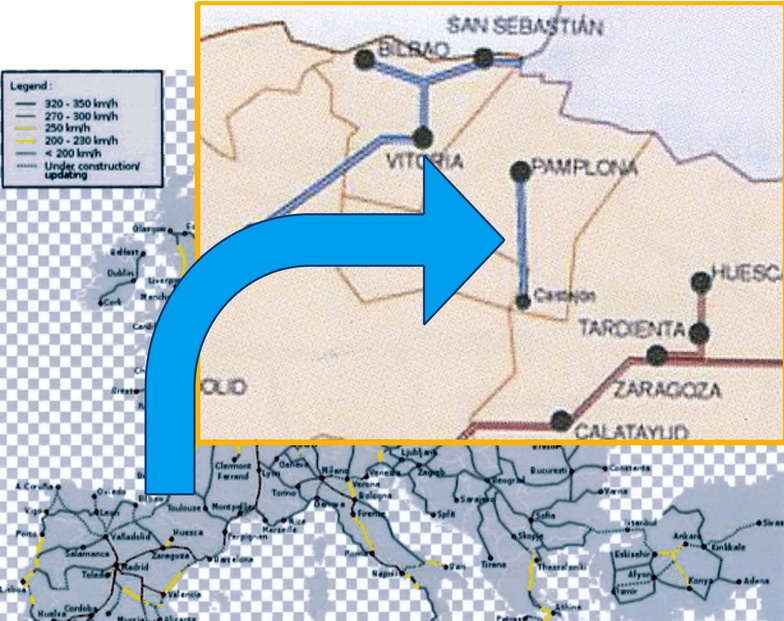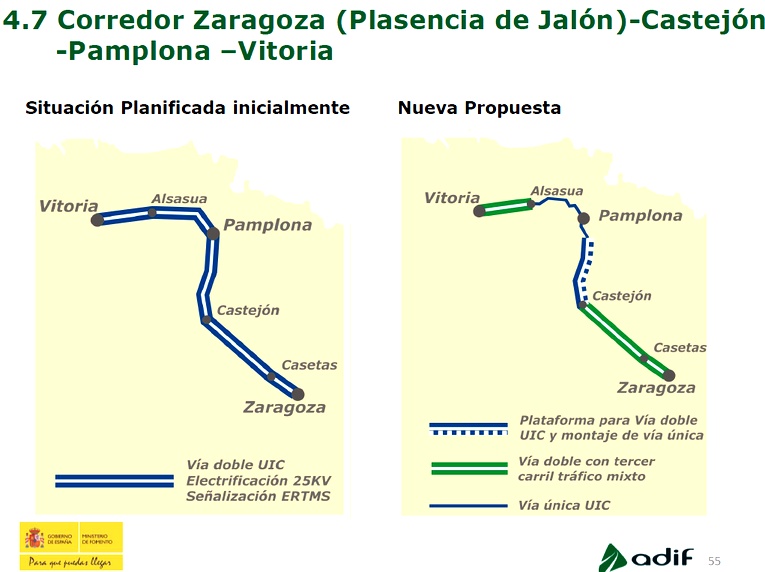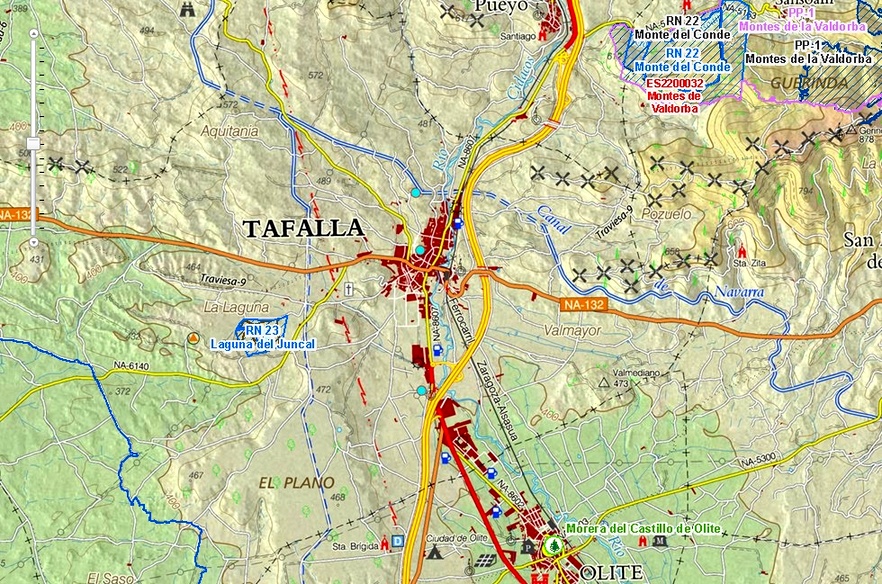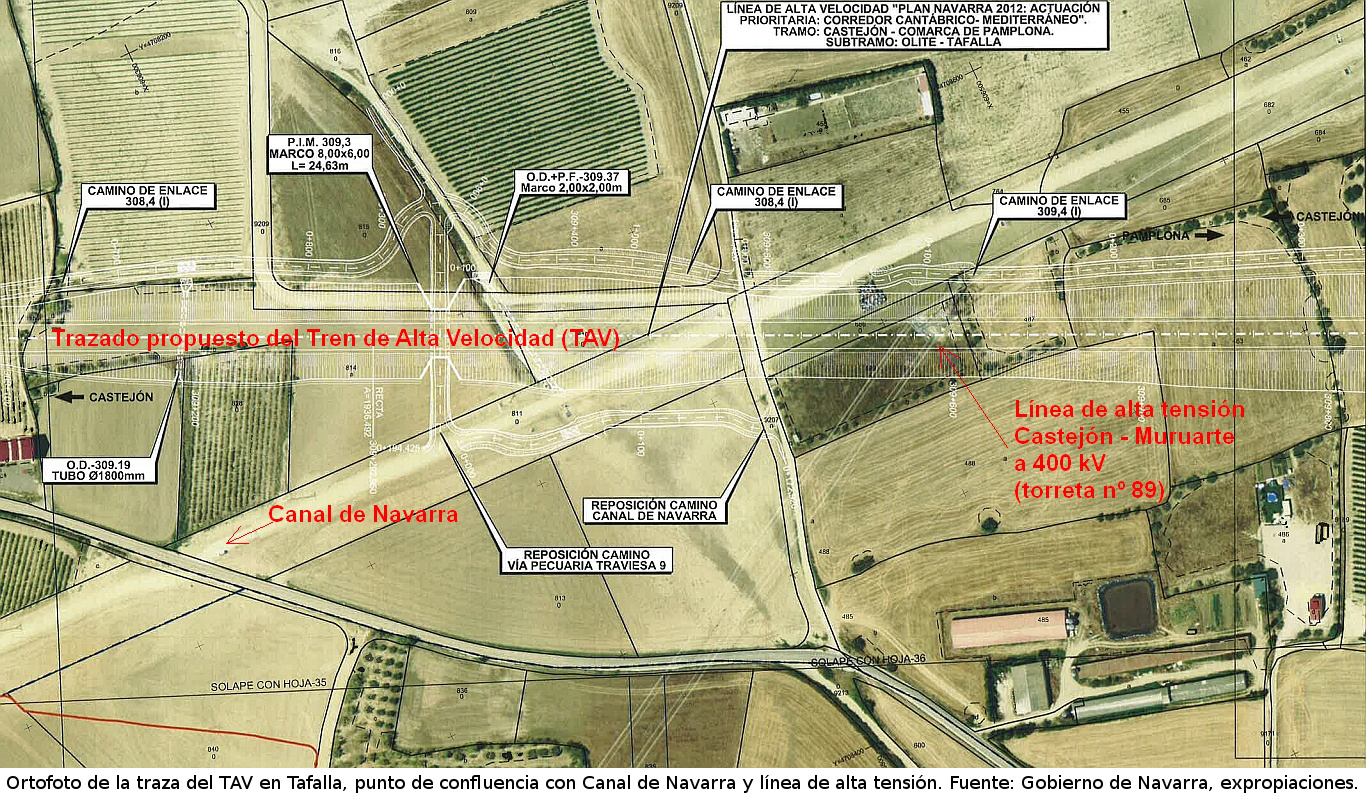 We present herewith a report on the construction of the high-speed train (HST) in Navarra prepared by the Foundation Sustrai Erakuntza. This report is being used to inform on the waste of money to build a HST in our region to various institutions of the European Union. You can access the report in PDF format (1,2 Mb) and epub format for ebooks (569 Kb). We have published a spanish version of this document, and a french version too.
We present herewith a report on the construction of the high-speed train (HST) in Navarra prepared by the Foundation Sustrai Erakuntza. This report is being used to inform on the waste of money to build a HST in our region to various institutions of the European Union. You can access the report in PDF format (1,2 Mb) and epub format for ebooks (569 Kb). We have published a spanish version of this document, and a french version too.
The construction of a new high-speed railway line of about 65 km but for a one-way (not two) of European gauge has started in the region of Navarra (Spain). The most striking fact is that it would have no foresight connection to any of its two ends. Planned expenditures would amount to approximately EUR 900 million (5% of Navarra’s GDP) from public sources that will never be amortised. In addition, a recent judgment has declared null and void the Environmental Impact Assessment (EIA) of the HST in Navarra.
|
Data on Navarra and its high-speed rail project |
Source |
|
|
Population (2011) |
644,566 inhabitants |
|
|
GDP (2010) |
€18,121 million |
|
|
Current passenger rail traffic (2011) |
664,512 passengers |
|
|
Current freight rail traffic (2011) |
331,921 tons |
Government of Navarra (PDF, page 97) |
|
Projected new railway line |
Around 65 kilometres |
Diario de Noticias de Navarra (newspaper) |
|
Current medium-term projected expenditures |
€887 million |
Diario de Noticias de Navarra |
|
Long-term projected expenditures |
Up to €4,470 million |
Government of Navarra (PDF, p. 66) |
|
Expenditures incurred (until end 2013) |
€55 million |
Foundation Sustrai (PDF, p. 23) |
The region of Navarra (Northern Spain) has a railway line in operation that crosses from north to south, communicating the Basque Country with the Aragon region and the Mediterranean. It is built on Iberian gauge and with one lane on most part (Alsasua-Castejón). Freight and passenger trains circulate on it. The latter are conventional trains or modern Alvia fit for circulation on Iberian and European gauge (UIC) The Alvia trains link Pamplona to Madrid and Barcelona (in 3 ½ hours and 4 hours, respectively), at high speed from Zaragoza.
In parallel, since 2011, another railway line is under construction for high speed trains (HST, or Tren de Alta Velocidad, TAV in Spanish) at European gauge, and single track (as confirmed by Luis Zarraluqui, the Director of Public Works of the Government of Navarra on June 18, 2013 in a public debate, before the project was for two lanes) and for the exclusive use of passengers, as stated in the project.
The layout of HST in Navarra is parallel to the current railway line. However, it has also important impacts on natural areas that are not affected by the current line, including protected ones as the Laguna del Juncal (pond), a natural reserve area (RN 23), among others. These enclaves are important habitats for nesting birds such as the little grebe, mallard, water rail, crake, moorhen and coot. They are also an important winter settlements for the marsh harrier and hen harrier. Thus, the environment of large areas of Navarra is damaged, and especially its Central Zone (Zona Media) that is already full of large infrastructures like the current railway line, the A15 motorway, the Canal de Navarra, power lines and large wind farms.
The authority for the construction of the HST in Navarra is the Ministry of Public Works (Fomento) of the Government of Spain, but the Ministry signed an agreement with the Government of Navarra, and now the work is performed by the regional government, advancing expenses. The central State announced said that will refund them (through ADIF, the state-owned company managing the railway infrastructures).
The initial project was to connect the high-speed railway line between Madrid and Barcelona, near Zaragoza, with the high-speed line is being built in the Basque Country, between Vitoria-Gasteiz and San Sebastian. There are actually two nearly parallel high speed rail projects in this corridor: Zaragoza- Castejón-Pamplona-“Basque Y” and Zaragoza-Castejón-Logroño-Miranda de Ebro-“Basque Y” (Ebro valley). From these two projects, only the first one, in Navarra, has minimally started.
The budget of the HST in Navarra for its 214 km which would form the full length, has increased from the initially planned EUR 1,842 million to EUR 3,853 million estimated by the Minister of Public Works of Spain in May 2013 (PDF file, p. 116), and even to EUR 4,470 million as projected in June 2013 by the current Director of Public Works of the regional government of Navarra (PDF file, p. 66).
This amount to be spent on the HST project in Navarra would account for 24% of the GDP of Navarra, with a population of 600,000. Considering that the current passenger traffic between Navarra and Madrid and Barcelona is only 500,000 a year, and adding a potential transit traffic, passenger figures would be far from the limit of economic viability (at least 5 million passengers per year) to justify and make profitable a new line and such an investment.
Obviously, there are no so much public funds in Spain and it is not expected the situation will change for a long time. Thus, the Government of Navarra has been forced to give up building the entire line. The new project is reduced to less than 65 km within the region of Navarra. The route would link Pamplona, capital of Navarra (although in reality the high speed would start from the town of Campanas, about 15 km south of Pamplona) and the village of Castejón (4,000 inhabitants!) in the South, where precisely works began in 2011. In such a short path length, trains could hardly reach their maximum commercial speed of 350 km/h.
This investment would cost around EUR 900 million, as it turned out by the press in May 2013. And for this, the Government of Navarra had to apply for a bank loan, paying interests that are estimated between EUR 45 and 60 million. Such extravagance is performed without preparing any detailed and reliable study on the socio-economic profitability of the HST in Navarra, nor on its maintenance expenses.
In addition, this new route does not have any direct connections to high-speed railway lines or with other lines at European gauge. To connect with the rest of the railway network, it is foreseen that the existing tracks in the region will be improved through the third rail track, as explained below.
Detailed information on the infrastructure development:
The report on the current status of the TAV in Navarra prepared by the Sustrai Foundation details every step followed until now. It can be seen that there is not a unique project for the entire layout. The connection Zaragoza – Basque Y is divided into at least 5 projects (corresponding to 5 sections). Here we describe the most important steps that have been taken so far:
In 1999, the Ministry of Public Works of Spain commissioned the first “Study of demand and profitability of the High Speed Railway Corridor in Navarra”. Their results hardly been disseminated only, and are unknown to the population of Navarra. Shortly afterwards, the Ministry prepared the first design plans and in 2004 approved definitely the Informational Studies, along with the Environmental Impact Assessments (EIA) of the High Speed Railway Corridor in Navarra. As we read literally, it was planned “the construction of a new track,” designed for “pure passenger traffic” (not goods) at “maximum speed of 350 km/h.” These technical constraints mean a much more demanding track (than choosing lower speeds), with greater environmental and territorial impacts.
In 2008, the Government of Navarra commissioned the study “Analysis of the economic, social and environmental impact of High Speed Train in Navarra.” The study was not publicly presented in the Parliament of Navarra until December 2011, once already started the construction of HST in Navarra. In his presentation, the Director of Public Works of the Government of Navarra recognized the irrelevance of this analysis for the implementation of the HST as economic conditions dramatically changed.
But the most serious is that this study was commissioned to collect only the positive benefits of the HST (as recognized in a Decision of the Ombudsman of Navarra). In addition, the government has denied access to this report for so long that it was finally the subject of an appeal to the Superior Administrative Court of Justice of Navarra for breaching regulations arising from the Aarhus Convention on rights to access environmental information. This sentence of December 2013 admits that the Foundation Sustrai is right, condemning the Government of Navarra for hiding this information and forcing it to submit all environmental information of the HST in Navarra.
In 2011, the first land expropriations started and the construction of the TAV in Navarra begun in Castejón with works that are still continuing. The first stage of the construction relies on an Environmental Impact Assessment made almost ten years ago, as if the environmental and social conditions had not changed. This has led to a legal recourse for the cancellation of the EIA and an administrative appeal to the High Court of Justice of Spain. Its sentence in the summer of 2013 declared expired and void the EIA of the TAV in Navarra. Thus, the project has been completely outside the legality. This fact was even recognized by the Government of Navarra for the stretch in Pamplona, but not for the stretch currently under construction, for which it has appealed.
Thus, in the absence of a social and economic justification for the project, the Foundation Sustrai publicly presents the results of an economic study of “Social profitability of the proposed high-speed railway in Navarra” (PDF file), conducted by the researchers Roberto Bermejo, Alejo Etchart and David Hoyos (of the University of the Basque Country – EHU).
The summary of their findings is the following:
- No reliable and independent study on the socio-economic profitability of the TAV in Navarra has been undertaken up to now. Its promotion lacks transparency and public participation. The project mostly corresponds to political and prestige motivations.
- Absence of economic profitability. The economic area of Pamplona could worsen its competitive position. In addition it will generate even more public debt.
- The project does not promote social nor territorial cohesion. It does not cover any lack of connection or add new communication possibilities to the existing ones.
- It does not contribute to environmental sustainability. Large uncertainties remain as to whether the HST in Navarra may transport significant levels of freight.
Meanwhile, in October 2011, the European Commission decided to integrate Navarra in the Cantabrian-Mediterranean corridor, at the request of the Ministry of Public Works of Spain. This involves the introduction of UIC standard gauge, which would be resolved by updating the current layout and installing a third track. This means that the current railway line would fit to European gauge, as it currently works in Huesca or Girona for both freight and passengers. But the Ministry specifies it should be a “path connecting the cities of Zaragoza and Santander, Bilbao and San Sebastián through Vitoria”. This means through the line Zaragoza-Logroño-Miranda del Ebro (not through the line Castejón-Pamplona-Alsasua, 108 km longer).
But in April 2013, the Ministry of Ministry of Public Works and the Government of Navarra announced in a press release the construction of the new high speed railway line between the Navarrese towns of Villafranca and Tafalla, continuing the work of the TAV already started in 2011 between Castejón and Villafranca. They said precisely: “This new route will connect with the rest of the network [ … ] through the maximum use of existing lines, making them compatible with the circulation of trains on international gauge. This will allow Navarre to integrate the European railways without breakage of load.” With this, we come to say that the idea here is to build a new line of 45 km (for high speed) more or less parallel to the current conventional railway line. And these new lines would connect with existing lines adapting these to international gauge (using the technique to add a third track between the two existing ones) to allow continuous traffic of goods between the Mediterranean and Europe through the corridor of Navarra, as decided by the European Commission in 2011 in its Trans-European Transport Network (TEN-T) for freight and passengers.
Thus, the Foundation Sustrai interprets both the Ministry of Public Works and the Government of Navarra are giving up de facto to continue its project of building a new railway line beyond Castejón to the South and Campanas (Pamplona area) to the North… That is, less than 65 km of European gauge line for high speed, an absurd and meaningless island!
Thus, we wonder: For what and for whom they want to build a new railway line between Castejón and Pamplona parallel to the current one? Why do they want to build it up? To maintain and finance the over-sized construction sector in Navarra and Spain? Perhaps it has something to do with the dominant political class that has already been able to charge illegal commissions prior to the award of the construction works…
January 2014
Annex I: Detailed information on paid expenditures and expected costs:
Expenditures incurred by the Government of Spain for the HST in Navarra until December 31, 2011:
The Minister for Public Works, Ana Pastor, unveiled on May 29, 2013 in the Spanish Parliament that spending made by the Ministry of Public Works between 2004 and 2011 for the construction of high-speed railway in Navarra, was EUR 11.9 million (see page 29 of the daily proceedings of the Congress of Deputies of Spain, in PDF format).
Expenditures incurred by the Government of Navarra for the HST until November 2013:
EUR 42.75 million, as published in this article.
Thus, the total spent by the end of 2013 for the TAV in Navarra would amount to some EUR 55 million although the data are probably not complete…
Projected expenditures
As seen from the above, the project has changed a lot during this period of time, including both the variation in the recorded sections and the prepared budgets. It is therefore difficult to make an exhaustive account of expected expenditures.
1. Expected costs for the connection of Pamplona with the high speed line in Zaragoza:
The section between Zaragoza and Pamplona was budgeted in 2007 by thehttp://www.fundacionwidows: 2; orphans: 2; width=westerntext-decoration: underline;sustrai.org/informe-situacion-del-proyecto-del-tav-navarroAarhus Convention class= Government of Navarra (document in Microsoft Word format) to EUR 1,030 million, of which EUR 470 million corresponded to the Zaragoza-Castejón stretch and EUR 560 million to the Castejón-Pamplona area stretch.
Later, in 2009, the Cortes-a href=dominant political classTudela-Pamplona stretch (i.e.,/a only in Navarra to the south from Pamplona to Zaragoza) was budgeted at EUR 1,500 million. In this budget, the cost of the stretch from Cortes to Plasencia Jalon in Zaragoza (around 73 km) does not appear.
The Castejón-Pamplona area stretch (which is under work at present, all of it in Navarra territory) was estimated at EUR 387 million in 2010 (only civil works for the platform) and thus they were included in the agreement of April 9, 2010 between the Government of Navarra and the Government of Spain.
But new estimates increase the budget to EUR 600 million, according to the Minister of Public Works announced in the Spanish Parliament in May 2013 (see news release). To this should be added at least another EUR 287 million expenses for the infrastructure (lines, electrification, signalling equipment, substations, safety and telecommunications), so that the section between Castejón and Campanas would reach a new minimum budget of EUR 887 million.
2. Expected costs for the entire corridor in Navarra (high speed between Zaragoza and the Basque Y):
The Minister for Public Works, Ana Pastor, recognized on May 29, 2013 in the Spanish Parliament that the budget for the construction of the high-speed railway in Navarra, based on studies of the year 2004!, was EUR 3,853 million (see p. 29 of the proceedings of the Congress of Deputies of Spain (PDF) and also this article). Furthermore, the Director of Public Works of the Government of Navarra rose that figure to EUR 4,000 million in his parliamentary appearance in May 2013.
But with the new plans that have been detailed in 2013 (high speed and third track on the medium-term, exclusive high speed on the long-term):
In the medium-term:
- Construction of the new high-speed railway line Castejón-Pamplona area (less than 65 km): EUR 600 million for the construction of the platform (civil works) and EUR287 million for the infrastructure (tracks, electricity …), EUR 887 million in total. See press article;
- Implementation of the third track between Castejón to Zaragoza and from Pamplona to the Basque Y with single UIC track until Alsasua and double track between Alsasua a Vitoria (EUR 318 million);
- Total projected expenditures in the medium term: EUR1,205 million. See the daily proceedings of the Parliament of Navarra (PDF document, page 66).
In the long-term: building of new lines for high speed in the remaining sections (Castejón-Zaragoza and Pamplona-Basque Y):
- EUR4,470 million, if the connection to the Basque Y would be through Ezkio-Itsaso (Guipúzcoa);
- EUR3,470 million, if the connection to the Basque Y would be through Vitoria-Gasteiz (Alava).
See press article or daily proceedings of the Parliament of Navarra (PDF document, page 66).
Annex II: Location maps

Map 1: Map of the TAV in Navarra prepared by the Government of Navarra, placed over a map of the Trans-European Transport Networks (TEN-T).

Map 2: Map of projects of the high speed railway line in Navarra (initial project and new proposal)
Source: Ministry for Public Works (Fomento) and Adif, April 2013, “Nuevo Modelo de Desarrollo de los Corredores de Alta Velocidad“.

Map 3: Map of the Tafalla area in the Zona Media (Central area) of Navarra, indicating existing infrastructure: highway (double yellow line), roads (red, orange and yellow lines), current railway (black line), Canal of Navarra (double blue line), electric power line (red dashed) and wind farm areas (blades in X). Protected areas like Laguna del Juncal (pond), or the mountains of Valdorba are also indicated. The route of the TAV would pass by near the Laguna del Juncal and El Plano, also an area of high natural value. Source: Spatial Data Infrastructure of Navarra (IDENA)
